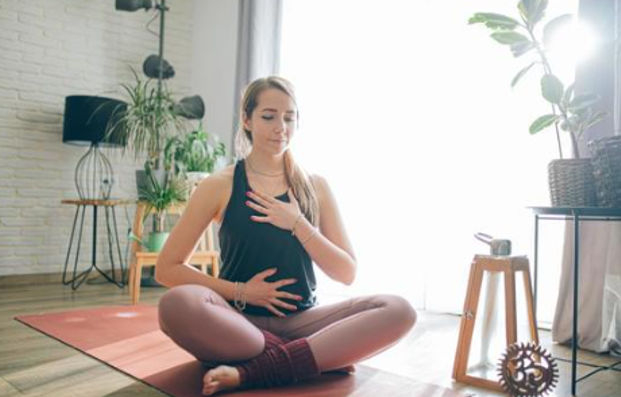Introduction
Somatic Yoga is a gentle, body-focused practice designed to enhance awareness of movement and sensation within the body.
The term “somatic” refers to the experience of the body from within, making Somatic Yoga a meditative approach to physical movement.
It combines elements of traditional yoga with somatic techniques, which emphasize slow, mindful movements.

This practice helps individuals release chronic tension, improve mobility, and promote deep relaxation.
By reconnecting with the body’s natural movements, Somatic Yoga encourages balance between the mind and body, fostering a sense of harmony and inner peace.
Steps to Perform Somatic Yoga
- Find a Quiet Space: Begin by selecting a quiet, comfortable space where you won’t be disturbed. Lie on a mat or soft surface in a relaxed position.
- Body Scan Meditation: Close your eyes and perform a body scan, gently shifting your attention to each part of your body. Notice areas of tension or discomfort and try to relax them.
- Breathing Practice: Focus on your breath. Inhale deeply, filling your lungs and abdomen, and exhale slowly. This deep breathing will help you relax further and bring awareness to your body.
- Somatic Movements:
- Start with small, gentle movements, such as rolling your shoulders, circling your wrists, or gently swaying your legs.
- Perform slow neck rolls, moving your head from side to side to relieve tension in the neck and upper back.
- Lie on your back, lift one leg, and rotate your foot in slow circles. Switch legs and repeat. These small, mindful movements activate the nervous system to release tension.
- Engage in pelvic tilts by gently lifting and lowering your pelvis while lying down. These movements help to realign the spine and alleviate lower back pain.
- Mindful Transitions: Transition between poses and movements slowly and mindfully, staying connected with your breath and bodily sensations. Pause after each movement to observe how your body feels.
- Rest and Reflect: After performing various somatic movements, lie down in Savasana (Corpse Pose) to fully relax your body. Let go of any remaining tension and reflect on how your body feels. Stay here for several minutes.
Benefits of Somatic Yoga
- Improved Body Awareness: Somatic Yoga encourages a deep connection between the mind and body, helping individuals become more aware of their physical sensations and movements.
- Release of Chronic Tension: The slow, controlled movements of Somatic Yoga help to release stored tension in muscles, joints, and tissues, providing relief from chronic pain and discomfort.
- Enhanced Flexibility and Mobility: By gently stretching and moving the body, Somatic Yoga improves flexibility, range of motion, and mobility without placing undue stress on the body.
- Stress Reduction: The focus on breath and mindful movement in Somatic Yoga promotes relaxation, reduces stress, and calms the nervous system, making it an effective practice for managing anxiety.
- Increased Mindfulness: Somatic Yoga encourages present-moment awareness, promoting mindfulness that extends beyond the yoga practice and into daily life.
- Better Posture: The practice of Somatic Yoga helps correct postural imbalances and misalignments, leading to better posture and reduced strain on the body.
- Holistic Healing: It supports the body’s natural ability to heal by addressing both physical and emotional stressors.
Precautions and Contraindications for Somatic Yoga
- Listen to Your Body: Somatic Yoga is all about tuning in to your body’s needs. If you feel discomfort or pain during any movement, stop immediately and adjust or modify the pose.
- Avoid Fast Movements: Since this practice emphasizes slow, controlled movements, avoid rushing through the exercises. Moving too quickly can lead to injury or strain.
- Consult a Healthcare Professional: If you have a pre-existing injury, chronic pain condition, or medical issue, consult your healthcare provider before beginning Somatic Yoga.
- Pregnancy Considerations: Pregnant women should practice under the guidance of a qualified yoga instructor who specializes in prenatal yoga, as some movements may need to be modified.
- Breath Control: Avoid holding your breath during the practice. Keep your breath flowing naturally to support the gentle movements.
- Spinal Issues: If you have a history of spinal problems or disc issues, take extra care during movements involving the spine and consult with a yoga therapist if needed.
Conclusion
- Somatic Yoga offers a unique, meditative approach to body awareness and movement, making it an ideal practice for those looking to relieve tension, increase flexibility, and promote a sense of overall well-being.
- Its emphasis on slow, mindful movements fosters a deeper connection between the mind and body, allowing for healing and transformation from within.
- Whether you’re looking to manage stress, improve mobility, or simply cultivate mindfulness, Somatic Yoga provides a gentle yet powerful way to support your physical and mental health.
- As with any practice, listen to your body, proceed with care, and enjoy the journey of self-discovery.
